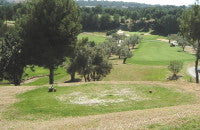Danger Zone - Drought could be this year's danger zone!
 Danger zones for the summer months can be highlighted as: increased wear from play pressure, drought stress, water shortage, shallow rooting, photo and heat scorch and specific summer diseases.
Danger zones for the summer months can be highlighted as: increased wear from play pressure, drought stress, water shortage, shallow rooting, photo and heat scorch and specific summer diseases.
Healthy turf resists summer stress. Winter and spring management and fertiliser operations should have set up the grass for a good summer performance, but you can take preventative and remedial actions throughout the summer.
Drought stress started early in 2011 throughout most of the UK. If dry conditions continue, drought stress will be the main danger to turf quality in the coming months. The pressure on water reserves and application systems will be great. Water restrictions may affect water availability in some areas. Best use of valuable water must be made. The following actions aim to maintain turf quality in dry conditions.
Excess wear during the main playing period is exasperated by dry conditions. Healthy turf on a well-structured soil or substrate stands up to wear well, but excess foot and trolley traffic may damage turf under stress. Alleviate this traffic damage by route changes wherever possible.
The integrity of the playing surface must be maintained, not only for functionality but also to avoid water loss from exposed substrate with resulting cracking and  erosion. Avoid any disturbance of the turf surface during very dry periods, as the organic cover binds the surface and maintains an even substrate temperature. Alternative strategies are needed to mechanical processes.
erosion. Avoid any disturbance of the turf surface during very dry periods, as the organic cover binds the surface and maintains an even substrate temperature. Alternative strategies are needed to mechanical processes.
Wetting agents or water management products aid the passage of water through the organic layer into the soil or substrate below. If dry patch is a severe problem, resulting from waxy and humic debris remnants of fungal mycelium, then wax breaking products may be needed in particularly water-repellent areas.
Wetting agents alone may not be able to penetrate these dry patch areas, resulting in almost no irrigation of the rootzone and run-off loss of water. Water management products not only aid penetration into the soil or substrate, they also aid the percolation laterally and vertically through the soil and attract water onto hydrophobic dry soil particles.
The soil is wetted effectively to the full rooting depth with a minimum of run-through. Wetting agents vary in their effect and longevity, some lasting up to six months. Nutrients can only enter the root hairs as simple ions in solution. Good water management ensures that the maximum root area is able to take up water and nutrients, increasing turf strength and reducing wasteful run-through.
Increasing root activity, root depth and root spread through the soil, increases drought resistance and overall stress. Phosphate and phosphite, amino acids and micorrhyzae all aid root health and root spread through the soil.

Phosphate is restricted by many managers to avoid encouraging unwanted annual grasses, but phosphate is essential for plant function and benefits root growth. Consider also phosphite, a highly active P formulation that stimulates root growth and aids energy transfer. Phosphites also boost the turf's defences against some root and foliar pathogens. Consider phosphite in your fertiliser programme from early spring onwards.
Amino acids encourage root-depth and stress resistance in dry periods. Chlorophyll production is also enhanced, further reducing drought danger. Amino acids can help reduce the stress and yellowing resulting from the application of many pesticides' plant growth regulators.
Fertilisers need careful application in dry weather. Residues and scorch are danger zones. Granular fertiliser requires irrigation after application to break down solid granules and transport the dissolved nutrients into the turf. Coated products, with slow delivery of nutrients, remain intact for weeks. This increases safety, as little fertiliser is given at any one time, but granules may be disruptive on the playing surface unless well worked in.

In all cases choose products that are homogenous, not blends, to give as even as possible application of all nutrients, avoiding scorch or speckling. Dry conditions enhance risk of scorch.
Water soluble or liquid fertilisers are useful through the main playing season. They leave nothing on the surface to be disruptive and have rapid effect. Low gifts of foliar fertilisers can remain on the leaf lamina for direct uptake. Higher doses of fertilise can be applied for rootzone feeding, then irrigated soon after application to both avoid scorch and transport the nutrients into the rootzone.
The nutrient content of the fertiliser should reflect seasonal and local variations. Consider the nutrient retentive qualities of your soil or substrate, the background nutrient level from analysis, especially phosphate, potassium and magnesium, time available for application in terms of man hours and access time, specific needs for tournaments and events, and that constant variable, the weather. It may be drought, what drought?
In addition to standard fertiliser needs, a number of mineral and organic substances aid summer stress resistance. Seaweed and other plant extracts can boost auxin and phytoalexin production and activity in turf. Zinc is directly involved in disease resistance and is often in short supply. Some bacteria such as Bacillus subtilis and some fungi e.g. Trichoderma asperellum protect roots and foliage from some pathogens. Plant nutrition involves far more than fertilisers.
